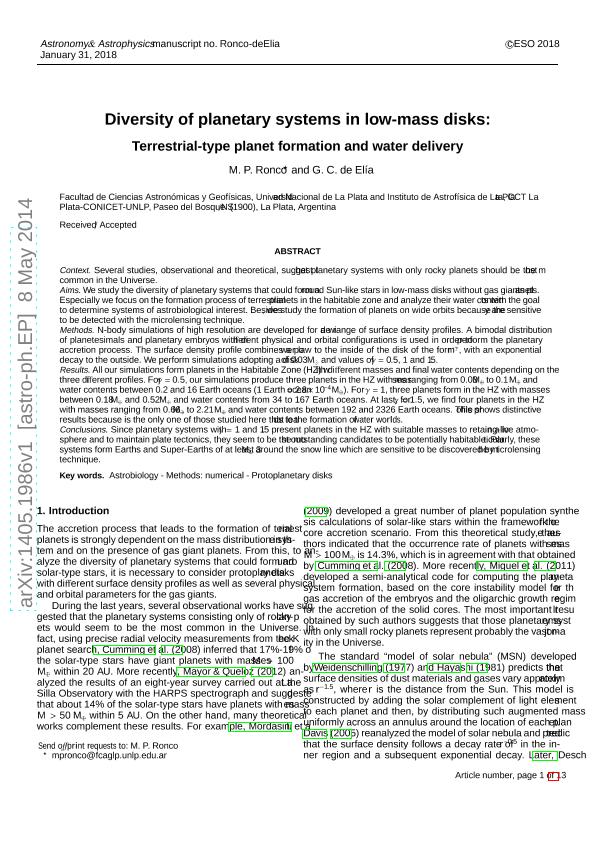Mostrar el registro sencillo del ítem
dc.contributor.author
Ronco, María Paula

dc.contributor.author
de Elia, Gonzalo Carlos

dc.date.available
2018-02-02T13:27:46Z
dc.date.issued
2014-07
dc.identifier.citation
Ronco, María Paula; de Elia, Gonzalo Carlos; Diversity of planetary systems in low-mass disks: Terrestrial-type planet formation and water delivery; EDP Sciences; Astronomy and Astrophysics; 567; A54; 7-2014; 1-13
dc.identifier.issn
0004-6361
dc.identifier.uri
http://hdl.handle.net/11336/35454
dc.description.abstract
Context. Several studies, observational and theoretical, suggest that planetary systems with only rocky planets are the most common in the Universe.<br />Aims. We study the diversity of planetary systems that might form around Sun-like stars in low-mass disks without gas-giant planets. We focus especially on the formation process of terrestrial planets in the habitable zone and analyze their water contents with the goal to determine systems of astrobiological interest. In adittion, we study the formation of planets on wide orbits because they can be detected with the microlensing technique.<br />Methods. N-body simulations of high resolution were developed for a wide range of surface density profiles. A bimodal distribution of planetesimals and planetary embryos with different physical and orbital configurations was used to simulate the planetary accretion process. The surface density profile combines a power law for the inside of the disk of the form r−gamma , with an exponential decay to the outside. We performed simulations adopting a disk of 0.03Msun and values of gamma = 0.5, 1 and 1.5.<br />Results. All our simulations form planets in the habitable zone (HZ) with different masses and final water contents depending on the three different profiles. For gamma = 0.5, our simulations produce three planets in the HZ with masses ranging from 0.03 Mearth to 0.1 Mearth and water contents between 0.2 and 16 Earth oceans (1 Earth ocean = 2.8× 10−4 Mearth). For gamma = 1, three planets form in the HZ with masses between 0.18 Mearth and 0.52 Mearth and water contents from 34 to 167 Earth oceans. Finally, for gamma = 1.5, we find four planets in the HZ with masses ranging from 0.66 Mearth to 2.21 Mearth and water contents between 192 and 2326 Earth oceans. This profile shows distinctive results because it is the only one of those studied here that leads to the formation of water worlds.<br />Conclusions. Since planetary systems with gamma = 1 and 1.5 present planets in the HZ with suitable masses to retain a long-lived atmosphere and to maintain plate tectonics, they seem to be the most promising candidates to be potentially habitable. Particularly, these systems form Earths and Super-Earths of at least 3Mearth around the snow line, which can be discovered by the microlensing technique.
dc.format
application/pdf
dc.language.iso
eng
dc.publisher
EDP Sciences

dc.rights
info:eu-repo/semantics/openAccess
dc.rights.uri
https://creativecommons.org/licenses/by-nc-sa/2.5/ar/
dc.subject
Astrobiology
dc.subject
Numerical Methosd
dc.subject
Protoplanetary Disks
dc.subject.classification
Astronomía

dc.subject.classification
Ciencias Físicas

dc.subject.classification
CIENCIAS NATURALES Y EXACTAS

dc.title
Diversity of planetary systems in low-mass disks: Terrestrial-type planet formation and water delivery
dc.type
info:eu-repo/semantics/article
dc.type
info:ar-repo/semantics/artículo
dc.type
info:eu-repo/semantics/publishedVersion
dc.date.updated
2018-01-12T16:18:30Z
dc.journal.volume
567
dc.journal.number
A54
dc.journal.pagination
1-13
dc.journal.pais
Francia

dc.journal.ciudad
Paris
dc.description.fil
Fil: Ronco, María Paula. Consejo Nacional de Investigaciones Científicas y Técnicas. Centro Científico Tecnológico Conicet - La Plata. Instituto de Astrofísica La Plata. Universidad Nacional de La Plata. Facultad de Ciencias Astronómicas y Geofísicas. Instituto de Astrofísica la Plata; Argentina
dc.description.fil
Fil: de Elia, Gonzalo Carlos. Consejo Nacional de Investigaciones Científicas y Técnicas. Centro Científico Tecnológico Conicet - La Plata. Instituto de Astrofísica La Plata. Universidad Nacional de La Plata. Facultad de Ciencias Astronómicas y Geofísicas. Instituto de Astrofísica la Plata; Argentina
dc.journal.title
Astronomy and Astrophysics

dc.relation.alternativeid
info:eu-repo/semantics/altIdentifier/doi/http://dx.doi.org/10.1051/0004-6361/201323313
dc.relation.alternativeid
info:eu-repo/semantics/altIdentifier/url/https://www.aanda.org/articles/aa/abs/2014/07/aa23313-13/aa23313-13.html
Archivos asociados
